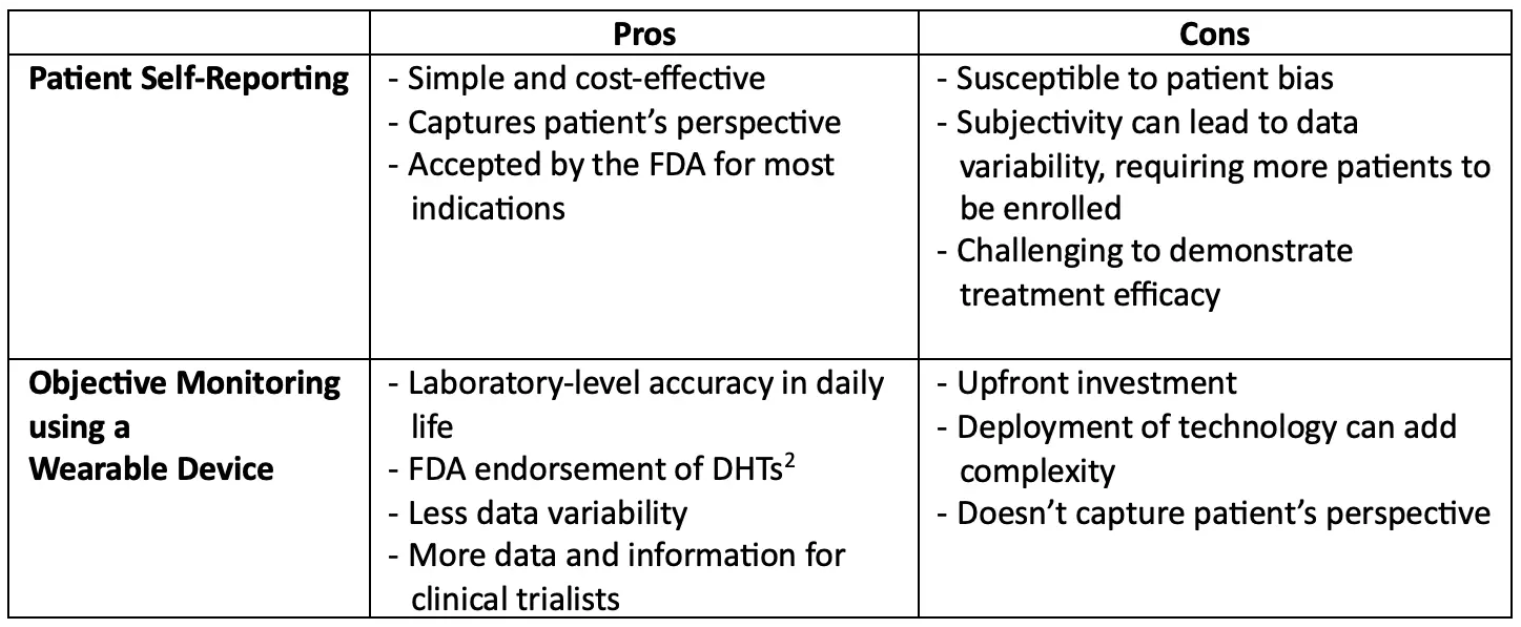Changes in symptoms such as coughing and/or wheezing are highly important endpoints in clinical trials focused on COPD, Asthma, IPF, Cystic Fibrosis, and other indications. With the growing availability of digital health technologies (DHTs) and wearables, it is now possible to measure these symptoms while patients are at home, allowing for objective 24-hour monitoring and greater insight into how treatments perform. Yet, patient self-reporting via questionnaires remains the dominant method for measuring these symptoms in clinical trials today. In this blog post, we delve into the benefits of leveraging both objective and subjective measures to gain a more complete understanding of treatment response, de-risk clinical programs and collect stronger evidence.
Patient Self-Reporting vs. Objective Measurement: Two Sides of the Same Coin
The choice between subjective and objective measures has long been a topic of debate in the field of clinical trials.¹ Subjective measures such as patient questionnaires provide valuable insight into patients’ experiences and perceptions. On the other hand, objective measures facilitated by digital wearables such as the RESP™ Biosensor offer the ground truth. By collecting real-world continuous data on lung sounds such as cough and wheeze patterns, duration, and intensity, researchers can potentially gain new types of insight into treatment response and how patients function in daily life. Based on our experience, we have compiled the main pros and cons of each approach.

Navigating Respiratory Trials: Balancing Patient Self-Reporting and Objective Measurement
Let’s explore both measurement approaches in the context of the primary ways that cough is measured in respiratory trials: cough frequency, intensity, and quality of life.
Cough Frequency
Cough frequency stands as a cornerstone measure in cough trials, particularly in chronic cough, idiopathic pulmonary fibrosis (IPF), and cystic fibrosis studies. While patient self-reporting through visual analog scales (VAS) or Leicester Cough Questionnaire (LCQ) offers valuable insights, recent advancements such as Strados Labs’ RESP™ Biosensor provide an objective gold standard for frequency measurement in clinical studies.
Studies have consistently highlighted a significant discrepancy between patient self-reported cough frequency and objective measures.³ Strados Labs collaboration with a research institute in the United States underscored this gap, revealing that 75% of patient-reported frequencies did not align with data captured from our device.⁴ This emphasizes the importance of objectivity in capturing this dimension of cough.
Cough Intensity
Cough intensity, describing the forcefulness of cough events, has traditionally been reported subjectively. Patient perceptions captured through VAS, LCQ, and Cough Severity Diary have played a pivotal role in assessing this dimension. Nonetheless, the advent of DHTs can introduce objectivity by analyzing cough spectrograms and determining intensity as an exploratory measure.
While objective measurements enhance precision, patient-reported intensity offers unique insights into how individuals experience and perceive their cough. Combining both approaches ensures a holistic evaluation.
Quality of Life
Measuring quality of life in cough trials spans physical, psychological, and social dimensions, making it a multifaceted consideration. While objective measurements contribute invaluable data, patient questionnaires like LCQ and Quality of Life Questionnaire allow individuals to convey the broader impact of cough on their overall well-being. Blending both approaches allows researchers to illuminate the full spectrum of how cough influences patient lives.
Conclusion: A Harmonious Blend for Comprehensive Insight
The decision to employ patient self-reporting or objective measurement in cough trials is far from binary. While opting for patient self-reporting may appear simpler, prioritizing objective measures – particularly for frequency assessment – offers several advantages. A combination of patient self-reporting and objective measurement using a clinically validated wearable can leverage the benefits of each method, providing a more complete understanding of treatment response and the most compelling evidence.
References:
- https://blog.theactigraph.com/blog/accelerate-clinical-development-with-patient-centric-digital-endpoints
- https://www.fda.gov/regulatory-information/search-fda-guidance-documents/digital-health-technologies-remote-data-acquisition-clinical-investigations
- Birring, S. S., & Spinou, A. (2015). How best to measure cough clinically. Current Opinion in Pharmacology, 22, 37-40. https://doi.org/10.1016/j.coph.2015.03.003
- Strados Labs abstract featured at 2023 American Cough Conference. https://stradoslabs.com/wp-content/uploads/2023/06/Poster-6.pdf

